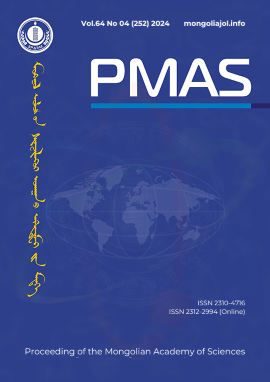Effects of nitrogen-fixing bacteria on seabuckthorn growth (Hippophae rhamnoides. L)
DOI:
https://doi.org/10.5564/pmas.v64i04.3980Keywords:
Nodules, biological fertilizers, mineral fertilizers, microorganismsAbstract
Mongolia's fertilizer industry produces 2,000 tons of fertilizer in 10 years, while imports amount to 6-8 tons a year. One of the main biological features of the root system of sea buckthorn is the ability to absorb nitrogen from the air with the help of its root nodules. The main goal of the research is to identify the native nitrogen-absorbing bacteria of sea buckthorn and to increase their activity by preparing bacterial fertilizers and determining their effects on plants. In our study, we obtained 2 types of nitrogen-fixing bacteria using common microbiological methods. Sea buckthorn mongolica subspecies was used in this study. The study of root nodules of sea buckthorn (Hippophae rhamnoides L.) aims to identify symbiotic nitrogen-fixing bacteria. Sea buckthorn root nodules contain Frankia actinorrhizal microorganisms. Sea buckthorn seedlings, including those fertilized with nitrogen-fixing bacterial cultures, showed a positive correlation with plant growth. From June to September, when air temperatures are high and photosynthesis active in the field, the number of bacterial cells and nitrogenase activity were found to elevate in the root nodules of sea buckthorn plants. During this period, the roots extended 1.4 to 2.0 meters in length. The first- and second-order small roots, along with the main root, began forming small nodules filled with microorganisms. These microorganisms play a crucial role in capturing nitrogen in its molecular form from the air and converting it into a form usable by plants. However, studies on the diversity and distribution of Frankia strains have been hindered by challenges in isolating them from field-collected root nodules. In the field, nitrogenase activity in root nodules remained high from May to September, corresponding with the periods of high air temperatures and active photosynthesis.
Downloads
245
References
1. Pawlowski.K, Bisseling, T., "Rhizobial and actinorhizal symbioses: what are the shared features?", " The Plant cell ", 1996. https://doi.org/10.1105/tpc.8.10.1899.
2. "Soil protection and fertilizer production technology." 2022.
3. Wall, L. G., "The Actinorhizal Symbiosis," J Plant Growth Regul, vol. 19, no. 2, pp. 167-182, Jun. 2000. https://doi.org/10.1007/s003440000027.
4. Benson, D. R., Isolation of Frankia Strains from Alder Actinorhizal Root Nodules, Applied and Environmental Microbiology. vols. 1982.
5. Benson, D. R., Silvester, W. B., "Biology of Frankia strains, actinomycete symbionts of actinorhizal plants, Microbiol Rev 57, vol. 1993. https://doi.org/10.1128/mr.57.2.293-319.1993.
6. Tjepkema, J. D. and Winship, L. J., "Energy Requirement for Nitrogen Fixation in Actinorhizal and Legume Root Nodules," Science, vol. 209, no. 4453, pp. 279-281, Jul. 1980. https://doi.org/10.1126/science.7384801.
7. Baitulin, I. O., The root system of agricultural plants, vol. Alma-Ata. (In Russian). 1976.
8. Benson, D. R., "Growth characteristics of the slow‐growing actinobacterium Frankia sp. strain CcI3 on solid media," Physiologia Plantarum, vol. 130, no. 3, pp. 391-399, Jul. 2007. https://doi.org/10.1111/j.1399-3054.2007.00866.x.
9. Baker, D. D., Mullin, B, "Diversity of Frankia nodule endophytes of the actinorhizal shrub Ceanothus as assessed by RFLP patterns from single nodule lobes.," vol. Soil Biol Biochem 26, pp. 547-552, 1994. https://doi.org/10.1016/0038-0717(94)90241-0.
10. Clawson, M. L., Caru, M., Benson, D. R., "Diversity of Frankia strains in root nodules of plants from the families Elaeagnaceae and Rhamnaceae.," vol. Appl Environ Microbiol 64, pp. 339-343, 1998. https://doi.org/10.1128/AEM.64.9.3539-3543.1998.
11. Hassen Gherbi, Katharina Markmann, Sergio Svistoonoff, "SymRK defines a common genetic basis for plant root endosymbioses with arbuscular mycorrhiza fungi, rhizobia, and Frankiabacteria,." 2008. https://doi.org/10.1073/pnas.0710618105.
12. Carole Santi, Didier Bogusz and Claudine Franche, "Biological nitrogen fixation in non-legume plants," vol. Annals of Botany 111. 2013. https://doi.org/10.1093/aob/mct048.
Downloads
Published
How to Cite
Issue
Section
License
Copyright (c) 2025 Ankhtuya Mijiddorj, Galt Lantuu, Ninj Badam

This work is licensed under a Creative Commons Attribution 4.0 International License.
Copyright on any research article in the Proceedings of the Mongolian Academy of Sciences is retained by the author(s).
The authors grant the Proceedings of the Mongolian Academy of Sciences a license to publish the article and identify itself as the original publisher.

Articles in the Proceedings of the Mongolian Academy of Sciences are Open Access articles published under a Creative Commons Attribution 4.0 International License CC BY.
This license permits use, distribution and reproduction in any medium, provided the original work is properly cited.

